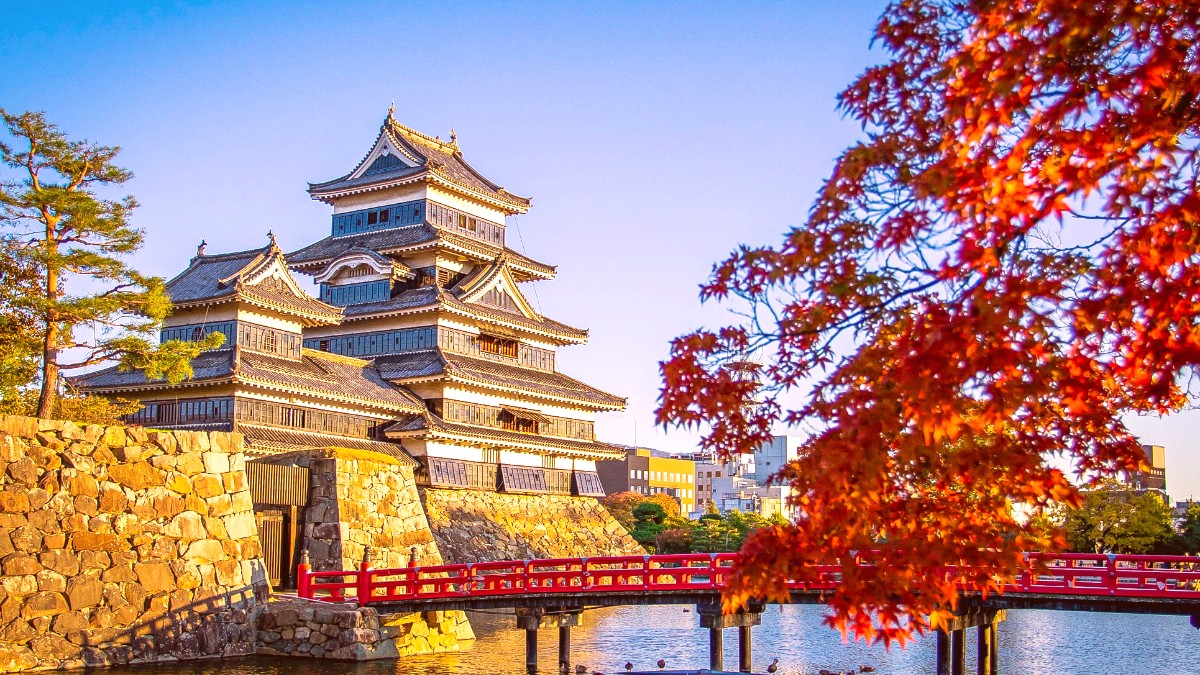
Central Honshu, Japan
Spring (March-May): Temperatures in spring are mild and gradually rise. March averages around 5°C (41°F), April reaches about 11°C (52°F), and May warms to approximately 16°C (61°F). Precipitation is less frequent than in summer. Cherry blossoms typically bloom in Matsumoto in mid-April. The air is often clear, and the surrounding mountains begin to shed their winter snow, revealing lush greenery. Spring days are comfortable for walking and sightseeing.
Summer (June-August): Summers in Matsumoto are warm to hot and often humid. June averages 20°C (68°F), July about 24°C (75°F), and August peaks at around 25°C (77°F). June to mid-July marks Japan’s rainy season, known as tsuyu, bringing the highest precipitation of the year. August can be hot, with high humidity levels. Despite the heat and potential rain, summer is a popular time for outdoor activities in the higher elevations of the Japanese Alps, where temperatures are cooler.
Your choice of travel dates can affect crowds, prices, and available activities.
Ideal Timing for Specific Activities: Cherry Blossoms (Mid-April), Hiking in Japanese Alps (Late April/May to early November), Autumn Foliage (Late October to mid-November), Skiing/Snowboarding (December to March), Onsen (year-round).
Peak Travel Times
Weather is often ideal for popular activities like cherry blossom viewing, alpine hiking, or enjoying autumn colors.
Higher prices for flights and accommodation. Attractions and transportation can become crowded. Advance booking for everything, especially accommodation, is wise.
Ideal Balance
You will find pleasant weather. Fewer crowds than in the high season, leading to a relaxed experience. Prices for accommodation and flights are often more reasonable.
The rainy season (tsuyu) in June to mid-July can bring consistent rain. While typhoons mainly affect coastal areas, their remnants can bring heavy rain and wind in September.
Quieter Experience
Fewer tourists create a quieter experience. Accommodation prices are often lower, offering good value. Enjoy unique winter experiences like snow-dusted landscapes and excellent skiing.
Cold weather and heavy snowfall can restrict movement. Some seasonal attractions might have limited hours or close entirely. Proper warm clothing is needed.
Japan's typhoon season typically runs from August to October. While Matsumoto is inland, strong typhoons can disrupt transportation networks nationwide and bring heavy rain and strong winds.
Significant snowfall happens in winter, specifically from January to February. This makes the city charming but needs careful preparation. Summers, especially August, can be hot and humid; dehydration and heatstroke are concerns. Drink plenty of water and seek shade.
Mid-April.
Late April/May to early November. Peak conditions are typically July to September.
Late October to mid-November.
December to March at nearby resorts.
Enjoyable year-round, especially soothing in autumn and winter.
Rules vary depending on your nationality and the purpose and duration of your visit.
Japan has a generous visa waiver program. Citizens of many countries, including the United States, Canada, most European Union nations, Australia, and New Zealand, do not need a visa for short-term stays. These short-term stays are typically up to 90 days and cover tourism, business meetings, visiting friends or relatives, or transit.
If your intended stay exceeds the visa waiver period, or if your purpose is for work, study, or specific long-term activities, a visa will be needed. The application processes are more involved. You generally apply at a Japanese embassy or consulate in your home country. This process involves submitting detailed documentation and meeting specific criteria.
Costs vary significantly based on your travel style.
Accommodation: ¥3,000 - ¥6,000 (hostel dorm, guesthouse). Meals: ¥1,500 - ¥3,000 (convenience stores, chain restaurants). Transportation: ¥500 - ¥1,500 (local bus, walking). Attractions: ¥500 - ¥1,000 (Matsumoto Castle, free sites). Total Daily Estimate: ¥5,500 - ¥11,500 (approximately $35 - $75 USD).
Accommodation: ¥8,000 - ¥15,000 (business/mid-range hotels). Meals: ¥3,000 - ¥7,000 (casual restaurants, izakayas). Transportation: ¥1,000 - ¥2,500 (frequent local buses, occasional short taxis, short train trips). Attractions: ¥1,000 - ¥2,500 (multiple museums, castle, gardens). Total Daily Estimate: ¥13,000 - ¥27,000 (approximately $85 - $175 USD).
Accommodation: ¥20,000+ (high-end hotels, ryokans with full service). Meals: ¥8,000+ (fine dining, exclusive restaurants). Transportation: ¥3,000+ (frequent taxis, private transfers, express trains). Attractions: ¥2,500+ (guided tours, private experiences). Total Daily Estimate: ¥33,500+ (approximately $220+ USD).
Matsumoto, and Japan in general, maintain high standards of public health and safety.
Ensure your routine vaccinations (MMR, DPT, Polio) are current. For longer stays or extensive rural travel, Hepatitis A & B, and Japanese Encephalitis are sometimes suggested.
Practice good hand hygiene and use hand sanitizer.
Pollen allergies (kafunsho) are common in spring (late February to May); bring your preferred medication.
Medical Care
Japan offers a high standard of medical care. Doctors and hospitals are available in Matsumoto. Many medical professionals speak some English. A translation app or local contact can be useful.
Drinking Water: Tap water is safe and potable throughout Japan, including Matsumoto.
Food Hygiene: Standards are exceptionally high. Eating street food is generally safe.
Ambulance/Fire: Dial 119; Police: Dial 110; Japan Visitor Hotline: 050-3816-2787 (24/7 support in multiple languages).
Medical care standards in Japan are high. Matsumoto has readily available doctors and hospitals. Pharmacies are known as kusuri-ya or "drug stores."
Many medical professionals speak some English. A translation app can be useful for communication.
Japan has one of the lowest crime rates in the world. Matsumoto is considered a very safe city. Violent crime against tourists is extremely rare. Petty crime, like pickpocketing, is uncommon, but awareness in crowded areas is good practice. No specific neighborhoods in Matsumoto are known for high crime rates. You can explore the city confidently, even at night.
A comprehensive travel insurance policy comes highly recommended for all travelers to Japan. It should cover: Medical Emergencies, Trip Cancellation or Interruption, Lost or Delayed Luggage, and Personal Liability.
Compare policies from reputable providers like Allianz Travel Insurance or World Nomads Travel Insurance. For medical and travel-related coverage for foreigners visiting the United States, consider Insubuy.
Keep a list of emergency contacts: Police (110), Fire/Ambulance (119), your country's Embassy/Consulate, and your hotel front desk.
Japan's low crime rates mean safe travel. Remain aware of your surroundings in crowded areas.